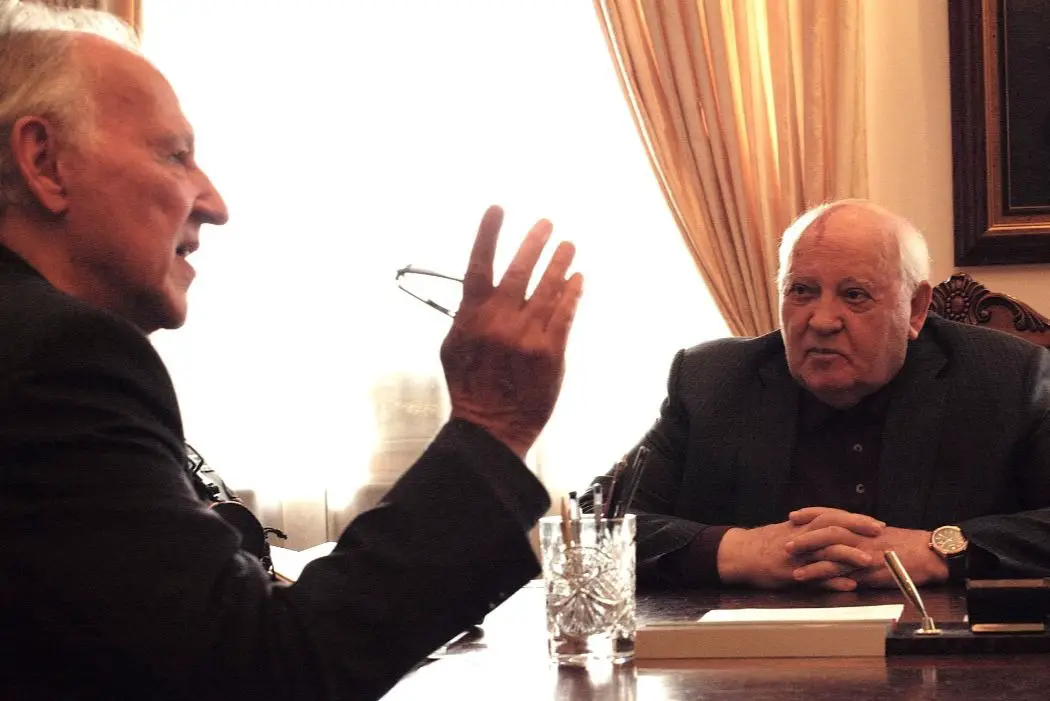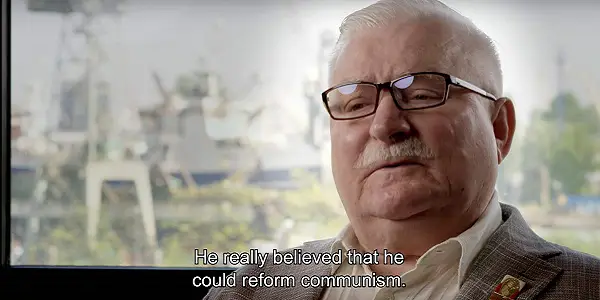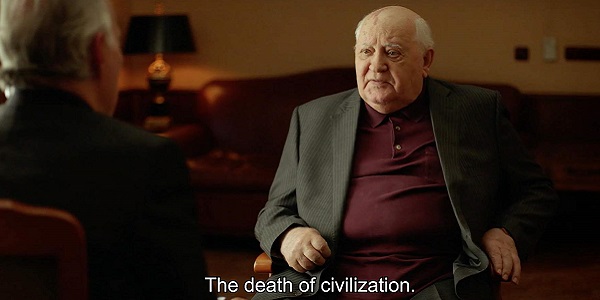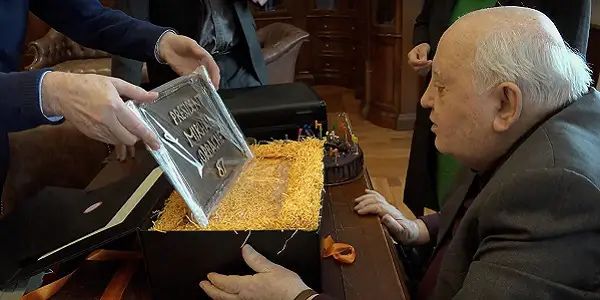MEETING GORBACHEV: A Portrait Of A Man & An Era

Lee Jutton has directed short films starring a killer toaster,…
The latest documentary from legendary German filmmaker Werner Herzog is Meeting Gorbachev, yet the film is about so much more than just the man cited in the title. Co-directed by Herzog and longtime friend and collaborator Andre Singer, Meeting Gorbachev takes a close look at the personal and political history of the man whose policies of perestroika and glasnost brought about the end of the Soviet Union and reflects on how little politicians today seem to have learned from that tumultuous period.
It’s clear that this is a time viewed by Herzog through a decidedly rose-colored pair of glasses, as it also led to the reunification of Germany, something he had desired personally for quite some time. Yet through his intrepid questioning of Gorbachev and other political figures of yesterday and today, Herzog makes a pretty good case for why he feels the legacy of Gorbachev deserves to be celebrated. It’s an entertaining, informative and poignant look at an era characterized by diplomacy and discussion — both of which are sadly thin on the ground in international relations today.
Learning From History
The opening sequence of Meeting Gorbachev just about perfectly summarizes the delightfully bizarre tone that Herzog brings to everything he has ever done. Upon meeting Gorbachev for the first time, the first thing Herzog does is apologize on behalf of the entire country of Germany for the atrocities of World War II. “The first German you ever met was probably trying to kill you,” he reasons in the almost cartoonishly thick accent that has become iconic over the years thanks to films like Little Dieter Needs to Fly and Grizzly Man. However, Gorbachev is quick to correct him. In fact, the first Germans he ever met were his neighbors in rural Russia, and his memories of them are only fond ones, as they frequently supplied him with delicious gingerbread.
From there, the film goes on to explore the rise of the man who would become the eighth and final leader of the Soviet Union: from his youth operating combine harvesters on a collective farm in the Stavropol region, to his days at Moscow University, where he met his beloved wife, Raisa (whose passing in 1999 still pains him), to his role as Party Secretary for Stavropol, to his return to Moscow as a member of the Politburo.

Gorbachev became General Secretary of the Communist Party in 1985 and almost immediately sought to reform the regime through perestroika (political and economic reconstruction) and glasnost (openness). Yet as Lech Walesa, the leader of the Polish Solidarity movement and later President of Poland, tells us in the film, the notion of reforming the regime was always going to lead to its dissolution, whether that was Gorbachev’s intention or not. Gorbachev, of course, says it was not — but we all know how that turned out.
After the Chernobyl disaster in 1986, Gorbachev became all the more convinced that things had to change — most importantly, that the Cold War and the escalating nuclear arms race had to end. He met with Ronald Reagan in attempts to negotiate nuclear disarmament, something that Gorbachev tells Herzog that he still firmly believes in; he is visibly proud of the role he played in decreasing the number of nuclear weapons out there in the world. Peace is a topic that Gorbachev and Herzog return to time and time again in their conversations — the struggle to strive towards it and the unlikelihood it will ever be achieved in this world, especially as current political rhetoric grows increasingly inflamed with anger and hatred.

Present Meets Past
Meeting Gorbachev combines these present-day interviews with archival footage that places the topics of their conversations in historical context — very helpful if, like me, you were born at the tail end of the Cold War era and have no recollection of these events as they were happening in real time. However, because it’s Herzog, this footage is not approached in a straightforward, straitlaced manner. In one particularly amusing segment, the film rushes us through the quick succession of old men who each briefly ruled the Soviet Union just prior to Gorbachev, from their feeble first speeches to their inevitable burial at the foot of the Kremlin wall with their predecessors. The quick glimpses of these elaborate state funerals, complete with over-accentuated marching and epic funeral dirges, somehow end up being the funniest moments in the film.
Gorbachev is now approaching his 90th birthday and in increasingly poor health; because he suffers from diabetes, Herzog and his crew gift him a massive sugar-free chocolate bar emblazoned with his name at the first of the three meetings that comprise the content of the film. (Gorbachev is very pleased with the gesture.) In the conversations with Herzog, he appears comfortable with his legacy; his one regret seems to be that he did not get to continue as leader of the new Russia after the dissolution of the Soviet Union in 1991. He continues to mourn Raisa nearly two decades after her passing; his deep affection for his wife of more than forty years is just one way that Herzog shows us the human side of this legendary figurehead.

Even though the film takes its name from him, Mikhail Gorbachev is not the only prominent figure from the Cold War era interviewed in the film. In addition to Walesa, as mentioned above, Herzog speaks to former Hungarian prime minister Miklós Németh and former U.S. Secretary of State George Shultz, among others. Despite their different perspectives on that time, one thing is clear throughout the film: Herzog loves Gorbachev. He doesn’t pretend otherwise — he even tells him so on camera! So, if you’re looking for a purely objective look at Gorbachev’s life, times and legacy, Meeting Gorbachev will not satisfy you. But as a portrait of one man’s impact on an era, from the viewpoint of another who lived through it, it is a fascinating film.
Meeting Gorbachev: Conclusion
Meeting Gorbachev is less about the man himself and more about what he represents to Herzog: a time when political leaders were willing to converse and compromise instead of issuing blustery threats of mutual mass destruction. The film forces you to think about how the world has changed in the relatively short span of time since Gorbachev was in power, and to wonder how and why we ended up where we are today.
What do you think? Does Meeting Gorbachev sound like a fitting addition to Herzog’s oeuvre? What would you like to see him tackle in future documentaries? Share your thoughts in the comments below.
Meeting Gorbachev was released in the U.S. on May 3, 2019 and will be released in the UK on November 8, 2019. You can find more international release dates here.
Does content like this matter to you?
Become a Member and support film journalism. Unlock access to all of Film Inquiry`s great articles. Join a community of like-minded readers who are passionate about cinema - get access to our private members Network, give back to independent filmmakers, and more.
Lee Jutton has directed short films starring a killer toaster, a killer Christmas tree, and a not-killer leopard. Her writing has appeared in publications such as Film School Rejects, Bitch: A Feminist Response to Pop Culture, Bitch Flicks, TV Fanatic, and Just Press Play. When not watching, making, or writing about films, she can usually be found on Twitter obsessing over soccer, BTS, and her cat.













